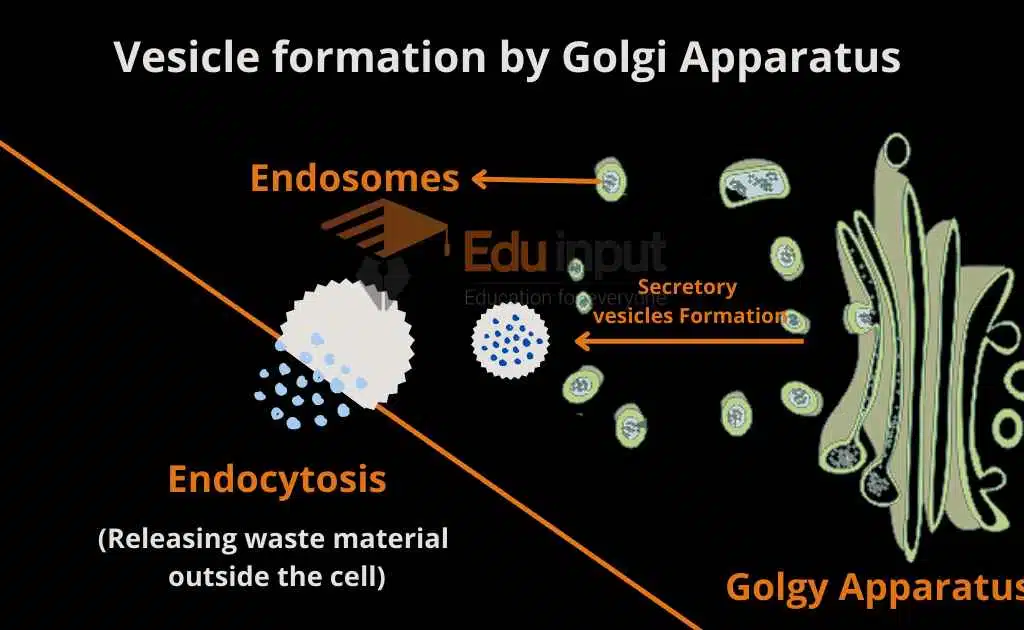Golgi Apparatus | Golgi Apparatus Structure | Golgi Apparatus Function
The Golgi apparatuses are piles of flattened membranous sacs called cisternae. They look like a pile of pita bread. A cell can have several interconnected stacks. Each cisterna in a stack consists of a membrane. The Golgi apparatus is present only in eukaryotic cells.
Each cistern in a stack consists of a membrane. This membrane separates the internal space of the Golgi apparatus from the cytosol. Vesicles are concentrated near the Golgi apparatus. They are used as a carrier to transfer material between the Golgi and other structures. After release from the Endoplasmic Reticulum, transport vesicles travel to the Golgi apparatus.
Golgi apparatus act as a manufacturing, storing, and transportation center. Then the products are modified and then sent to other parts of the cell.
Discovery of Golgi Apparatus
The existence of the cell organelle which is now known as the Golgi apparatus or Golgi complex was firstly reported by Camillo Golgi in 1898. He described it as an ‘internal reticular apparatus’ impregnated by a variant of his chromogenic staining. It soon became clear that the newly-identified cytoplasmic structure occurred in a variety of cell types.
However, the reality of the organelle was questioned for decades, until it was finally ascertained with electron microscopy.
Structure of Golgi Apparatus
The Golgi apparatus consists of two poles. The thickness of the membranes of cisternae and molecular composition are different at opposite ends of a stack. The two poles of a Golgi stack are
The cis-Face :
The cis face is located near the Endoplasmic reticulum.
The trans Face:
This is the receiving and shipping department of the Golgi apparatus.

Formation of secretions in the Golgi Apparatus
The following steps take place during the formation of secretions:
1. Transport vesicles move material from the Endoplasmic reticulum to the Golgi apparatus. A vesicle buds off from the ER. They form transport vesicles. This transport vesicle fuses with the cis face of the Golgi apparatus and transfers its contents to the Golgi membrane.
2. The trans face gives rise to secretory vesicles. These secretory vesicles pinch off and travel to other sites.
3. ER products are modified during transport from the cis pole to the trans pole of Golgi proteins. Various Golgi enzymes modify the oligosaccharide portions of glycoproteins. The glycoprotein oligosaccharides are identical in the ER.
Golgi removes some sugar monomers and replaces others. They, therefore, produce different types of oligosaccharides. The trans face of the ribosome budded off as a secretory vesicle.
4. The secretory vesicles fuse with the plasma membrane. This product is finally exported.

Golgi Apparatus Functions
Golgi complex performs the following functions:
1. Cell secretions:
Golgi complex is concerned with cell secretion. There are the following steps in the process of cell secretions.
- The ribosomes synthesize the protein part of the cell secretions.
- The endoplasmic reticulum transfers it to the Golgi apparatus.
- Golgi apparatus converts the secretion to finished products.
- These secretions are packed inside the membrane to form granules.
Finally, granules are exported outside the cell membrane. For example in mammals Pancreas secretes granules containing enzymes that help in digestion.
2. Transportation:
Golgi apparatus transports the proteins or enzymes outside the cell.
3. Formation of Glycoproteins and glycolipids: It is the most important function of the Golgi
apparatus. They add carbohydrates to protein and lipids to form some glycoprotein and glycolipids.
Frequently Asked Question-FAQs
What is Golgi Apparatus?
Golgi apparatus is an intracellular organelle, that aids in the packaging of protein and lipid to export from the cell.
What is the main function of Golgi apparatus?
The Golgi apparatus primarily functions for the transport of material inside the side. Golgi Vesicles facilitate the transport of protein and lipids.
Who discovered Golgi bodies?
In 1898, Camillo Golgi reported the presence of the Golgi apparatus in cells.
How many Golgi bodies are present in a cell?
Animal cell generally contains 10-20 Golgi stacks per cell.







Leave a Reply